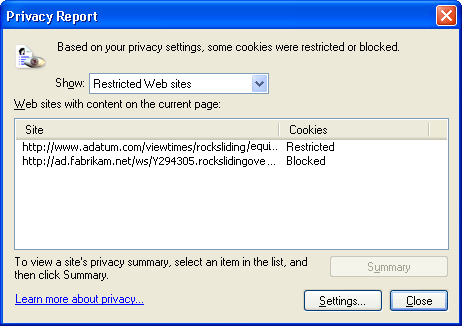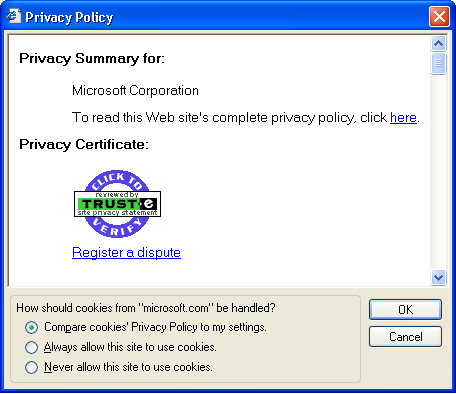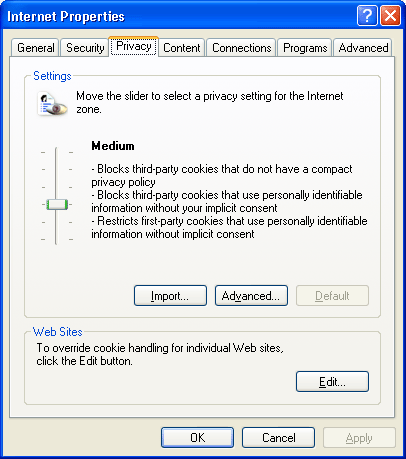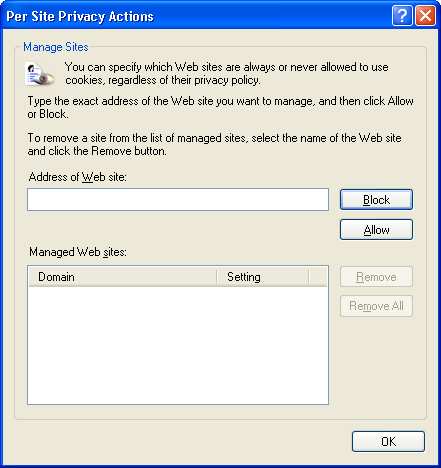Platform for Privacy Preferences Project
Platform for Privacy Preferences Project
The Platform for Privacy Preferences Project, or P3P, was defined by the World Wide Web Consortium (W3C). P3P permits Web sites to define their privacy statements by using XML and predefined codes known as the P3P compact policy. This combination of XML and the compact policy can be read by browsers such as Microsoft Internet Explorer 6, which now include the P3P capability. P3P-aware browsers can warn users when a Web site they are visiting has questionable privacy practices or no privacy statement whatsoever. By using P3P to define your privacy statement, you ensure that visitors to your site easily understand your company s position on privacy and how your site will handle their personal data. If you do not implement P3P for your Web site, visitors might be reluctant to remain at or return to your site.
P3P Integration for Internet Explorer 6
One new feature of Internet Explorer 6 is its ability to interpret the P3P privacy policy of a Web site. Based on its interpretation of your Web site s P3P privacy policy, Internet Explorer 6 will block, restrict, or accept a cookie that your site attempts to send out. A cookie can be blocked or restricted when the privacy setting in Internet Explorer 6 is inconsistent with the privacy policy for a Web site or when a Web site does not have P3P integration at all. Restricting a cookie means that it will be available only for the current session and will not be stored on your computer. Blocked cookies are neither stored nor used during the session. If a cookie is blocked or restricted, Internet Explorer 6 will display the icon shown in Figure 29-1 in the lower right-hand corner of the browser window.

Figure 29-1. Internet Explorer 6 P3P warning icon
This is not what you want you want visitors to your Web site to see. You should work to keep this icon from being displayed when the privacy setting for Internet Explorer 6 is set to Medium, which is the default setting. The Medium setting indicates that when a user visits a Web site, first-party cookies will be restricted and third-party cookies will be blocked when the Web site uses personally identifiable information (PII) without the user s consent or when the site has not implemented P3P. (First-party cookies are cookies placed by a Web site that a user is visiting. Third-party cookies are cookies placed by a Web site other than the one a user is visiting, which is something banner ads typically do.) PII is any information about a user that can be used to identify or locate him. A user s name, address, and phone number are considered PII. An IP address, a GUID, or an account ID can be considered PII when they can be correlated with a user s PII.
Internet Explorer 6 performs a P3P interpretation of sites only within the Internet, Trusted sites, and Restricted sites zones, not the Local Intranet zone.
By double-clicking the P3P warning icon, you can see whether a cookie was blocked or restricted. Figure 29-2 shows an example of a dialog box that might be displayed after you click this icon.

Figure 29-2. Privacy report from a site with a blocked cookie
Viewing a Site s Privacy Statement
Internet Explorer 6 can be used to view a Web site s privacy statement if the site has implemented P3P. By selecting Privacy Report from the View menu, you will see the translated version of the site s XML privacy statement. Figure 29-3 shows the privacy statement from the Microsoft Web site.

Figure 29-3. Summary of the privacy statement from the Microsoft.com site
By clicking the Here link, you can access the site s full privacy statement. Notice that the TRUSTe logo is visible, which can be an added comfort for visitors to your site.
Internet Explorer 6 Privacy Settings
The Internet Explorer 6 browser has several dialog boxes that permit you to control cookies by way of the privacy settings you select. Figure 29-4 shows a diagram of the Privacy tab on the Internet Properties dialog box, which can be accessed by selecting the Tools menu and then clicking Internet Options.

Figure 29-4. Internet Explorer 6 Internet Properties dialog box, with the Privacy tab selected
You can override the handling of cookies based on their type by selecting the Advanced button in the Privacy tab of the Internet Properties dialog box. Figure 29-5 shows the dialog box that is displayed when the Advanced button is selected.

Figure 29-5. Internet Explorer 6 Advanced Privacy Settings dialog box
You can override the handling of cookies for a specific Web site by selecting the Edit button on the Internet Properties dialog box. Figure 29-6 shows the dialog box that is displayed when the Edit button is selected.

Figure 29-6. Internet Explorer 6 Per Site Privacy Actions dialog box
Implementing P3P for Your Web Site
Implementing P3P requires you to create four pieces of content. Except for the full privacy statement, each of these pieces of content is based on the P3P specification shown at http://www.w3.org/p3p/. The first piece of content is the reference file, which is an XML file that is used to point to the XML version of your privacy statement. This file should be named P3p.xml and stored in W3C directory beneath the root of your Web site. For example, the Microsoft.com P3P reference file follows and can be found at http://www.microsoft.com/w3c/p3p.xml.
<?xml version="1.0" ?> <META xmlns="http://www.w3.org/2000/12/P3Pv1"> <POLICY-REFERENCES> <POLICY-REF about="http://www.microsoft.com/w3c/p3policy.xml"> <INCLUDE>/*</INCLUDE> </POLICY-REF> </POLICY-REFERENCES> </META>
The second piece of content is the XML version of your privacy statement. This file describes the data that is collected and how it is used. It represents the condensed form of your full privacy statement. This file also points to the full version of the privacy statement. The name and placement of this file is not fixed. The location of the file needs to be indicated in the reference file. This is the file that is processed by the Internet Explorer 6 Privacy Report dialog box. The XML version of the privacy statement for Microsoft.com can be found at http://www.microsoft.com/w3c/p3policy.xml.
The third piece of content is the full privacy statement, which is pointed to by the XML privacy statement. The full privacy statement should indicate in simple language your company s privacy policy. See Defining a Privacy Statement earlier in the chapter for more information on how to create a privacy statement. The full privacy statement for Microsoft.com can be viewed at http://www.microsoft.com/info/privacy.htm.
The fourth piece of content is the P3P compact policy, which is the compact representation of the XML privacy statement. The values for the XML tags of the XML privacy statement are converted to codes. These codes are placed into the header of HTTP responses.
Establishing Corporationwide Policy Settings
Within your corporation, you will want to ensure that your employees understand the risks of visiting certain Web sites when the tables are turned and they step into the role of Web site user. You might want to distribute a list of restricted sites for employees to enter into their privacy settings for Internet Explorer 6. You might also want employees to choose a privacy setting above Medium to help protect them from dishonest Web sites. In either case, your employees should be trained on the privacy settings for Internet Explorer 6.Specific information about the privacy features of Internet Explorer 6 can be found at http://msdn.microsoft.com/library/en-us/dnpriv/html/ie6privacyfeature.asp and in Chapter 10, Securing Microsoft Internet Explorer 6 and Microsoft Office XP, in this book.
EAN: 2147483647
Pages: 189